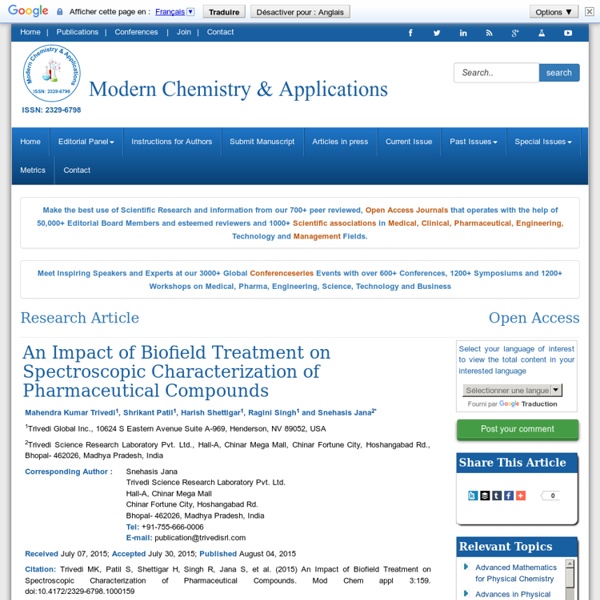An Impact of Biofield Treatment on Spectroscopic Characterization of Pharmaceutical Compounds
Abstract The stability of any pharmaceutical compound is most desired quality that determines its shelf life and effectiveness. The stability can be correlated to structural and bonding properties of compound and any variation arise in these properties can be easily determined by spectroscopic analysis. The present study was aimed to evaluate the impact of biofield treatment on these properties of four pharmaceutical compounds such as urea, thiourea, sodium carbonate, and magnesium sulphate, using spectroscopic analysis. Each compound was divided into two groups, referred as control and treatment. The control groups remained as untreated and treatment group of each compound received Mr. Tables at a glance Figures at a glance
http://www.esciencecentral.org/journals/an-impact-of-biofield-treatment-on-spectroscopic-characterization-of-pharmaceutical-compounds-2329-6798-1000159.php?aid=57988
Bio-field Treatment: An Effective Strategy to Improve the Quality of Beef Extract and Meat Infusion Powder
Share this: Embed* Cite this: Trivedi, Mahendra Kumar (2015): Bio-field Treatment: An Effective Strategy to Improve the Quality of Beef Extract and Meat Infusion Powder. figshare. Retrieved 10:40, Nov 19, 2015 (GMT)
Effect of Biofield Treatment on Spectral Properties of Paracetamol and Piroxicam
Title: Effect of Biofield Treatment on Spectral Properties of Paracetamol and Piroxicam Publication:
"An Effect of Biofield Treatment on Multidrug-resistant Burkholderia ce" by Mahendra Kumar Trivedi
Abstract Burkholderia cepacia (B. cepacia) is an opportunistic, Gram negative pathogen which causes infection mainly in immunocompromised population and associated with high rate of morbidity and mortality in cystic fibrosis patients. Aim of the present study was to analyze the impact of biofield treatment on multidrug resistant B. cepacia. Clinical sample of B. cepacia was divided into two groups i.e. control and biofield treated. The analysis was done after 10 days of treatment and compared with control group.
"Antimicrobial Sensitivity Pattern of Pseudomonas fluorescens after Bio" by Mahendra Kumar Trivedi
Abstract Global emergence of Pseudomonas fluorescens (P. fluorescens) displays a mechanism of resistance to all existing antimicrobials. Due to its strong ability to acquire resistance, there is a need of some alternative treatment strategy. Objective of this study was to investigate the effect of biofield treatment on antimicrobial sensitivity pattern of P. fluorescens. P. fluorescens cells were procured from MicroBioLogics in sealed packs bearing the American Type Culture Collection (ATCC 49838) number.
Publication meta - Antimicrobial Sensitivity, Biochemical Characteristics and Biotyping of Staphylococcus saprophyticus: An Impact of Biofield Energy Treatment
Staphylococcus saprophyticus (S. saprophyticus) is a frequent cause of urinary tract infection in the young women. The current study was designed to analyze the effect of biofield energy treatment on S. saprophyticus for evaluation of its antibiogram profile, biochemical reactions pattern and biotyping characteristics. Two sets of ATCC samples were taken in this experiment and denoted as A and B. Sample A was revived and divided into two parts Group (Gr.I) (control) and Gr.II (revived); likewise, sample B was labeled as Gr.III (lyophilized).
Phenotyping and 16S rDNA Analysis after Biofield Treatment on Citrobacter braakii: A Urinary Pathogen
Title: Phenotyping and 16S rDNA Analysis after Biofield Treatment on Citrobacter braakii: A Urinary Pathogen Publication: Journal of Clinical & Medical Genomics
Spectroscopic Characterization of Chloramphenicol and Tetracycline
Open Access Research Article Pharmaceutica Analytica Acta h
Evaluation of Antibiogram, Genotype and Phylogenetic Analysis of Biofield Treated Nocardia otitidis
*The embed functionality can only be used for non commercial purposes. In order to maintain its sustainability, all mass use of content by commercial or not for profit companies must be done in agreement with figshare. Description Nocardiosis is a soil-borne aerobic infection caused by Nocardia species commonly affects the respiratory tract. Nocardia otitidis (N. otitidis) is the key organism for non-mycobacterial tuberculosis. The current study was attempted to investigate the effect of Mr.
Effect of Biofield Treatment on Barium Titanate Powder
Abstract Barium titanate, perovskite structure is known for its high dielectric constant and piezoelectric properties, which makes it interesting material for fabricating capacitors, transducer, actuator, and sensors. The perovskite crystal structure and lattice vibrations play a crucial role in its piezoelectric and ferroelectric behavior. In the present study, the barium titanate powder was subjected to biofield treatment. Further, the control and treated samples were characterized using X-ray diffraction (XRD) and Fourier transform infrared spectrometer (FT-IR) and Electron spin resonance (ESR).
"Antimicrobial Sensitivity, Biochemical Characteristics and Biotyping o" by Mahendra Kumar Trivedi
Abstract Staphylococcus saprophyticus (S. saprophyticus) is a frequent cause of urinary tract infection in the young women. The current study was designed to analyze the effect of biofield energy treatment on S. saprophyticus for evaluation of its antibiogram profile, biochemical reactions pattern and biotyping characteristics.
"Phenotyping and 16S rDNA Analysis after Biofield Treatment on Citrobac" by Mahendra Kumar Trivedi
Description Citrobacter braakii (C. braakii) is widespread in nature, mainly found in human urinary tract. The current study was attempted to investigate the effect of Mr.
Related:
drjohnmalik
Related:



